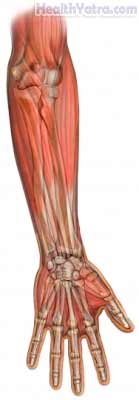Definition
A forearm muscle strain is a partial or complete tear of the small fibers of the forearm muscles. Forearm muscles allow you to extend and flex your wrist and fingers.
It is a common injury in sports. It is also common in people who work in jobs with repetitive keyboard motions. Treatment depends on the severity of the strain.

Causes
A forearm muscle strain is caused by:
- Stretching the forearm muscles beyond the amount of tension they can withstand
- Suddenly putting stress on the forearm muscles when they are not ready for stress
- Overusing the forearm muscles over time
- Getting a direct blow to the forearm muscles
Risk Factors
Factors increase your chance of developing forearm muscle strain include:
- Participation in sports that overuse the forearm
- Previous strain or injury to the area
- Muscle fatigue
- Weak or tired muscles
- A job that requires repetitive movements that strain the forearm muscles
Symptoms
Symptoms may include:
- Problems flexing your fingers or wrist
- Pain while stretching the fingers or wrist
- Area feels tender and sore
- Muscle spasms
- Swelling
Diagnosis
The doctor will ask about your symptoms and medical history. A physical exam will be done.
Most forearm muscle strains can be diagnosed with a physical exam. Your doctor may want images of the area if severe damage is suspected. Images may be taken with x-ray or MRI.
Muscle strains are graded according to their severity:
- Grade 1—Some stretching with micro-tearing of muscle fibers.
- Grade 2—Partial tearing of muscle fibers.
- Grade 3—Complete tearing of muscle fibers. This may also be called a rupture or avulsion.
Treatment
Talk with your doctor about the best treatment plan for you. Recovery time ranges depending on the grade of your injury. Treatment steps may include:
Acute Care
Rest
Your muscle will need time to heal. Avoid activities that place extra stress on these muscles:
- Do not do activities that cause pain.
- Do not play sports until your doctor has said it is safe to do so.
Cold
Apply an ice or a cold pack to the area for 15-20 minutes, four times a day, for several days after the injury. Do not apply the ice directly to your skin. Wrap the ice or cold pack in a towel.
Pain Relief Medications
To manage pain, your doctor may recommend:
- Over-the-counter medication, such as aspirin, ibuprofen, or acetaminophen
- Topical pain medication—creams or patches that are applied to the skin
- Prescription pain relievers
Compression
Compression can help prevent more swelling. Your doctor may recommend an elastic compression bandage around your forearm. Be careful not to wrap the bandage too tight.
Elevation
Elevation can also help keep swelling down. Keep your arm higher than your heart as much as possible for the first 24 hours or so. A couple of days of elevation might be recommended for severe strains.
Recovery Steps
Heat
Use heat only when you are returning to physical activity. Heat may then be used before stretching or getting ready to play sports to help loosen the muscle.
Stretching
When the acute pain is gone, start gentle stretching as recommended. Stay within pain limits. Hold each stretch for about 10 seconds and repeat six times. Stretch several times a day.
Strengthening
Begin strengthening exercises for your muscles as recommended.
If you are diagnosed with a forearm muscle strain, follow your doctor’s instructions.
Prevention
To help reduce your chance of getting forearm muscle strain, take the following steps:
- At work, use an ergonomic keyboard or workstation.
- Keep muscles strong. This will help them absorb the energy of sudden stressful activities.
- Avoid overexercising.
- Learn the proper technique for sports.
- If you are feeling tired, stop exercising.
